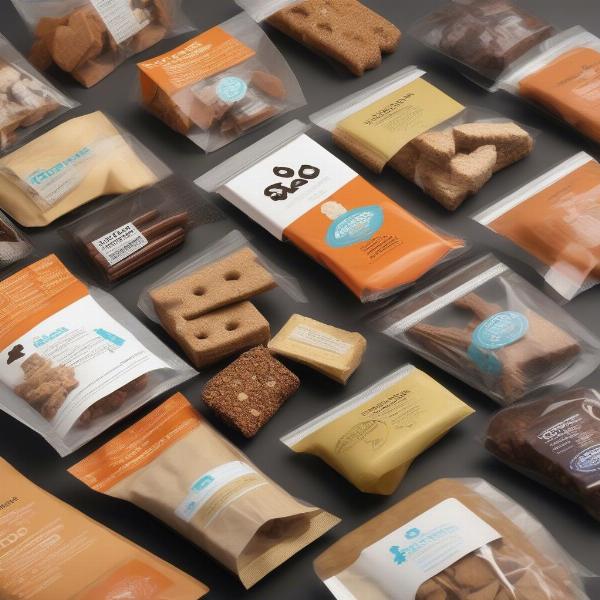Dog treats are a staple for many pet owners, used for training, rewarding good behavior, or simply showing affection. But have you ever stopped to consider the packaging that holds these tasty morsels? Dog treat packaging isn’t just about aesthetics; it plays a crucial role in preserving freshness, palatability, and overall safety. This article dives deep into the world of dog treat packaging, exploring everything from material choices and design considerations to the importance of proper storage and disposal.
Understanding the Importance of Dog Treat Packaging
Choosing the right dog treat packaging is essential for maintaining the quality and safety of your dog’s treats. Proper packaging protects against spoilage due to exposure to air, moisture, and pests. It also helps retain the flavor and aroma, ensuring your furry friend enjoys every bite. Furthermore, good packaging provides important information about the product, including ingredients, nutritional value, and best-by dates.
Key Considerations When Choosing Dog Treat Packaging
Several factors influence the choice of packaging for dog treats. The type of treat, its shelf life, and target audience all play a role. For instance, soft, chewy treats require airtight packaging to prevent them from drying out, while crunchy treats benefit from packaging that protects against breakage.
Material Selection for Optimal Freshness
The material used for dog treat packaging significantly impacts the product’s longevity and safety. Common options include:
- Plastic: A versatile choice offering various levels of barrier protection against moisture and oxygen. Look for BPA-free options for added safety.
- Metal: Provides excellent barrier properties and can be recycled. Cans and tins are often used for premium dog treats.
- Paper and Cardboard: Eco-friendly options suitable for certain types of treats, often combined with inner linings for added protection.
Design Elements for Enhanced Appeal
Packaging design plays a crucial role in attracting consumers. Eye-catching colors, clear labeling, and informative descriptions can make a product stand out on the shelves. Resealable features are also highly desirable, allowing for easy storage and maintaining freshness.
 Attractive and Functional Dog Treat Packaging Designs
Attractive and Functional Dog Treat Packaging Designs
Safe Storage and Disposal of Dog Treat Packaging
Once you’ve purchased your dog treats, proper storage is crucial. Always store treats in a cool, dry place away from direct sunlight and moisture. Reseal the packaging tightly after each use to maintain freshness.
When it’s time to dispose of the packaging, check for recyclability symbols and follow local guidelines. Some packaging materials can be recycled, while others may need to be disposed of in general waste.
Navigating the World of Sustainable Dog Treat Packaging
Increasingly, pet owners are seeking eco-friendly options. Look for packaging made from recycled materials, biodegradable options, or those with minimal environmental impact. working dog food often has specialized packaging considerations.
How to Spot Signs of Spoiled Dog Treats
Even with proper packaging and storage, dog treats can spoil. Look for signs of mold, discoloration, unusual odor, or a change in texture. If you notice any of these signs, discard the treats immediately.
Conclusion
Dog treat packaging is more than just a container; it’s a vital component of ensuring your dog’s treats remain fresh, safe, and appealing. By understanding the different types of packaging, material choices, design considerations, and proper storage practices, you can make informed decisions and provide your furry friend with the best possible treats. Always remember to check the packaging for important information and prioritize safety when selecting and storing dog treats. You might also be interested in learning about alligator dog treats.
FAQ
- What are the most common types of dog treat packaging? Bags, boxes, tubs, and pouches are common choices.
- What is the best material for dog treat packaging? The best material depends on the type of treat and desired shelf life. Plastic, metal, and paper are commonly used.
- How can I tell if my dog treats have gone bad? Look for signs of mold, discoloration, unusual odor, or texture changes.
- Is dog treat packaging recyclable? Check the packaging for recyclability symbols and follow local guidelines.
- Where should I store dog treats? Store in a cool, dry place away from direct sunlight and moisture.
- Why is resealable packaging important? It helps maintain freshness and prevents spoilage.
- What should I look for on dog treat packaging labels? Ingredients, nutritional information, best-by date, and manufacturer details.
ILM Dog is your trusted resource for expert advice on dog care and nutrition. We offer a wealth of information on breeds, health, training, and much more. We are also experts in providing information regarding frontline plus for dogs 2-10kg and fromm large breed dog food. From breed selection to health care and nutrition, ILM Dog offers comprehensive guidance to support the well-being of your canine companion. Contact us at [email protected] or +44 20-3965-8624 for personalized support.